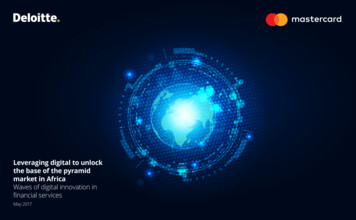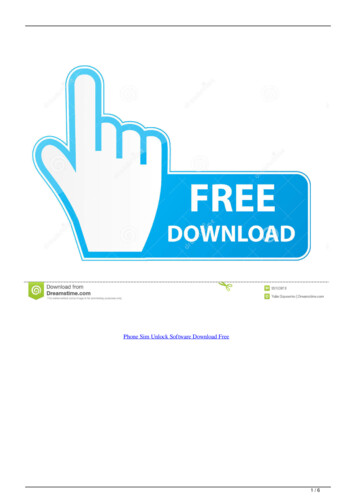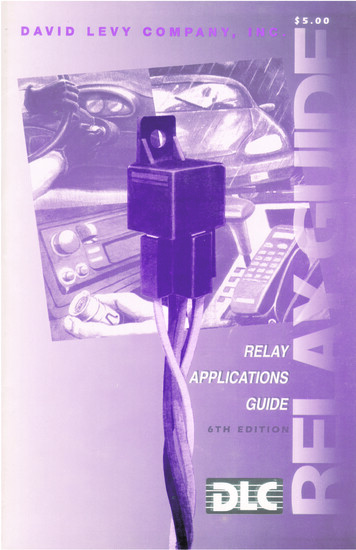
Transcription
Leveraging digital to unlockthe base of the pyramidmarket in AfricaWaves of digital innovation infinancial servicesMay 2017
ContentsForeword.3Developing a more financially-inclusive Africa.4Digital disruption in the financial services industry is inevitable.5Africa’s large untapped markets require innovative products and business models.8First Wave: Mobile money – paving the way for future financial innovations.12Second Wave: Leveraging First Wave innovations to expand financial service offerings for the base of the pyramid. 16Third Wave: Platforms – the convergence and aggregation of financial services.20Success factors.22Concluding remarks.24Endnotes.25Contacts.26
Leveraging digital to unlock the base of the pyramid market in Africa ForewordExcept for South Africa, the level of formal banking and insurance penetration across Africa remains low. However,the industry’s potential – particularly for products that are tailored to the needs of the low-income segment at thebase of the pyramid (BoP)1 – remains largely untapped. Half of South Africa’s work force falls into the BoP incomebracket.2 This proportion is likely to be much higher in the rest of Africa.Although BoP consumers represent the majority of spending power in Africa, their low income has been seen asa hindrance to providing products and services through traditional distribution models. For example, traditionalfinancial service providers (FSPs) that rely on bricks-and-mortar branches, ATMs, and the payment infrastructureof banks, have struggled to capture BoP consumers. This is partly because of high costs linked to their traditionalmodels, as well as an element of mistrust that clouds part of the industry.New market entrants have started to disrupt traditional business models by introducing digital technology atvarious parts of the value chain. We have unpacked these in three waves of innovation in Africa’s financial servicesindustry. New entrants leverage mobile technology, often through partnerships, cloud computing and advanceddata analytics, to bring down costs, achieve reach and increase trust. In particular, partnerships with mobilenetwork operators (MNOs) enable these new entrants to leverage an existing customer base and solutions such asmobile wallets to streamline credit extension, premium collection and claim pay-outs. This is a game changer forthe financial services industry and is helping to unlock Africa’s mass market.As a team we welcome your thoughts and considerations on this report.Roger VersterFinancial Services Industry LeaderDeloitte Africa3
Leveraging digital to unlock the base of the pyramid market in AfricaDeveloping a more financially-inclusive AfricaThe significant impact that digital technology has played in Africa thus far is expected to gain even more momentum.This will be a key tool for ensuring that all Africans are financially empowered and able to achieve their full potential. From micro merchants and smallholder farmers, to women andthose currently discounted, it is critical that all sectors come together to develop robust digital financial ecosystems. Developing a more inclusive Africa will take a combination ofstrong partnerships, relevant financial solutions and a willingness for governments to move beyond cash. There are a number of trends currently impacting financial inclusion.1. Mobile as an acceptance toolIt is fair to say that technology has completely transformed society in a few shortdecades. Innovations are creating novel ways of engaging with friends and family,but also new ways to do business, both locally and across borders. Mobile inparticular is driving innovation in how people transact. Africa is moving to the nextlevel of economic interconnectedness with an increasing appetite for simplifyingthe bartering process – whether this is lowering the barriers to the formal financialinfrastructure, or providing greater access to acceptance solutions. Africans arehaving their say with their mobile wallets.4. Electronic identity solutionsWe take for granted the fact that we each have a formal identity – a way to provewho we are, empowering us to open up a bank account, or apply for a loan. Many inAfrica do not have this basic right, and with many governments this is a key priority.With new electronic ID cards available, this is the future of financial inclusion. Itis also providing a safe and convenient way for people to interact with the worldaround them – giving the financial sector an opportunity to overlay with a paymentsolution that turns the eID card into a payment tool.2. Digitising key value chainsRecent industry studies showcase the importance of digitising the value chain.Interestingly, executives consider digital design (and manufacturing) to be acritical driver of competitiveness, and believe digital adoption and adaptation is asenior leadership priority. Successful implementation of digital solutions entailsfluid digital communication across the value chain. The continuous flow of data isthe digital thread. And as the current trend indicates, organisations that do notcapitulate to the demands of their customers may cease to be relevant, or evencease to exist, in a few years.Although digital payments are key to achieving a more inclusive Africa, debit andprepaid solutions are helping to overcome initial barriers and levels of comfort withelectronic payments. This is an important first step for many that are unbanked orunder-banked.3. Remittance ensuring more secure money transfer solutionsHistorically, cross-border currency exchange has been a painful endeavour.Surprisingly, this is how the bulk of Africa operates, as well as several marketsacross Europe, the United Arab Emirates (UAE), and Asia. Today, however, onlinemoney transfers have become one of the safest ways to send friends or familymembers the support they need; it is exceedingly convenient and involves onlya nominal cost. Remittance in Africa is in many cases the only way people cantransact, and therefore a lifeline.4Raghu MalhotraPresident, Middle East and AfricaMastercard
Leveraging digital to unlock the base of the pyramid market in Africa Digital disruption in the financial services industry is inevitableTraditional banking and insurance providers face disruption as technology companies leverage digital solutions to the established industry.In Digital disruption – Short fuse, bigbang?,3 in 2012 Deloitte predictedthe extent to which an industry willbe disrupted by digital across twodimensions: the size or degree ofimpact, and the imminence or timingof change. This prediction is comingto fruition.Degree of impact – the bang:The degree of impact is expressedas a percentage of changes inbusiness. The higher the percentage,the greater the impact. The biggerthe bang, the bigger the impact.Timing of the impact – the fuse:The fuse is the timeframe withinwhich the disruption is expected.The shorter the fuse, the shorter thetimeframe.Like other industries, global bankingand insurance are facing disruptionby technology players. However,we expect this disruption to beimminent and to be sizeable inimpact: short fuse and big bang.4In recent years, technology-drivencompanies have entered thefinancial services industry, applyingdigital solutions to an establishedand at times sluggish industry, andbringing disruption to different partsof the value chain. Due to the highlevel of regulation in the financialsector, the room for innovation andchange seemed limited for manytraditional FSPs. Regulation also ledto high barriers to entry, shieldingthe incumbents from new marketentrants.Digital solutions allow companiesto provide services at a lowercost, and to be more flexible andcustomer-centric. The entry of digitaldisrupters is accelerating the rate ofchange and is increasing the impactof change.While fintech players are changingthe way consumers transact, saveand access credit, in the insuranceindustry, digital is changing the wayindividuals purchase insurance.There are various ways that digitalis disrupting the financial servicesindustry: blockchain technology has thepotential to provide a fast, costeffective, and highly reliablealternative to traditional databasesin the banking and insurancesectorFigure 1. Deloitte’s Global Disruption MapShort Fuse, Big BangICT &MediaRetailLong Fuse, Big ssionalServices data analytics allow companiesto gain new customer insightsand tailor products to the specificneeds of their customers digital communications suchas chatbots enhance customerengagement by simplifyingapplications for users.Companies that embrace digitaldisruption are well positioned tobecome leaders in their respectiveindustries and will be able to unlocknew markets and improve theirmargins.In Africa, these digital disruptorsare best positioned to unlock thecurrently under-serviced massmarket.EducationImpact (% of change in business)Across many sectors, businessesface increasing competition fromplayers outside their industry thatare leveraging the power of digitalto disrupt traditional businessmodels. This is achieved throughthe introduction of new technology,which in turn forces the incumbentsto change the way they think andoperate.ManufacturingHealthcareUtilitiesReal EstateAgricultureGovernmentLeisureTiming (years)TransportationFood ServicesConstructionShort Fuse, Small BangMining, Oil, Gas,ChemicalsLong Fuse, Small BangSource: Deloitte, 20155
Leveraging digital to unlock the base of the pyramid market in AfricaDigital disruptors in the global financial services sectorDigital disruptors tend to have different objectives depending on the maturity of their markets.Figure 2. Examples of digital disruptors in the financial services sector in the rest of the worldUKGermanyCuvvaPay-as-you-go car to-peer car, home contents, legalexpenses and private liability coverage.Partnerships with 70 insurance providersAtom BankBranchless, digital bankDevelopingmarketsSpixiiDigital insurance agency deploying chatbotsChinaAttract customers awayfrom incumbent providersIn established and maturemarkets, new market entrantsoffering digital products/services tend to lure customersaway from traditional financialservice providers due to moreattractive prices, more flexibleand consumer-friendly models.6ZhonganOff-beat insurance products (covering alcoholpoisoning, heat and flight delays) and e-commercereturn insurance.Backed by Alibaba, Tencent and Ping AnAttract unserved firsttime customersDigital products/servicesoffered in developing countriestend to have the objective toreduce costs to a level that theproducts become accessibleto low-income groups thatare perceived to be notviable for traditional financialproducts. They also introducenew distribution models andpayment channels that tendto make their products morealigned to the needs andrequirements of low incomeconsumers.Huize InsuranceOnline insurance agency platform connected to theinternal systems of over 60 insurance companiesallowing consumers to compare and purchasemore than 700 insurance productsAlipayOnline payment system handling half of China’sonline transactions and part of the AlibabaecosystemUSALemonadePeer-to-peer household/rental insurance.Leverages AI to sell insurance and to settle claimsIndiaTelenor SurakshaFree life insurance forsubscribers to Telenor’snetwork.Partnership with Sriram LifeInsurance and MicroEnsureKabbageOnline automated lending platform for smallbusinessTrovOn-demand household insurance.Partnership with traditional insurance company totarget the UK marketBettermentRobot-advisor investment appBrazilNuBankBranchless, digital FSP.Issues Mastercard credit cardsYouse100% online based insurance providerPayTMIndia’s largest mobilepayments and commerceplatform.Over 200m usersAustraliaProspaOnline lending platform to small business
Leveraging digital to unlock the base of the pyramid market in Africa 7
Leveraging digital to unlock the base of the pyramid market in AfricaAfrica’s large untapped markets require innovative products and business modelsTech-driven companies and digital business models are well positioned to disrupt the formal financial services marketas they offer cost-effective and scalable solutions that can capture the mass market.Research by the World Bank,5 TheCentre for Financial Regulation andInclusion (Cenfri),6 The MastercardFoundation,7 Swiss Re Foundation8and Munich Re Foundation9 haveshown the positive socio-economicimpact of access to affordablefinancial products such as credit,savings and insurance. These playa crucial role, both in unlockingeconomic opportunities and inreducing poverty, by helping BoPconsumers to mitigate the effectsof negative financial shocks, and indoing so reducing vulnerability andavoiding the poverty trap.In a first wave of disruption inAfrica’s financial services sector,fintech companies started, mainlyoff the back of telecommunicationcompanies’ distribution capabilities,to disrupt the banking sectorby developing innovative digitalbanking and payment solutions.While formal banking penetrationremains low in Africa, the robustuptake in mobile wallets as analternative to traditional transactionservices reflects the strong demandfor financial products tailored to theneeds of the BoP (see Figure 3).The case of Safaricom’s mobilewallet, m-Pesa, is well documented8and has shown that servicing theBoP can be commercially viable.The model of mobile paymentsolutions independent from bankaccounts has been replicated byother MNOs in various marketsacross Africa and beyond.As with banking, insurancepenetration remains below 2%10 inmost African markets (see Figure4).11 According to the NationalInsurance Commission of Nigeria,3 million adults in Nigeria hadinsurance cover, while more than14 million adults indicated in a 2014study conducted by EnhancingFinancial Innovation & Access,a financial sector developmentorganisation in Nigeria, that theywere interested in insurance cover.12This mismatch of cover and interestfor low-cost insurance productsreflects the sizeable potentialaffordable insurance offerings inunder-serviced markets. The lowpenetration rate also reflects theinability of traditional insuranceproviders to service the BoPprofitably.Financial products for the BoP haveto consider the unsteady cash flowof low income consumers. Giventhat affordability is fundamental tounlocking the BoP market, productsneed to be offered at the right pricepoint and designed to be rapidlyscalable. The reliance on bricks-andmortar branches, ATMs or brokernetworks undermine the ability ofestablished FSPs to reduce the costof service and limit the reach thesecompanies can achieve, as newphysical branches require sizeableadditional investments. Given thelow banking penetration, insurancecompanies are not able to rely onthe traditional payment channelsprovided by banks for premiumcollection and claim pay-outs.An additional consideration for theinsurance industry is the aspect oftrust by consumers in insuranceproducts. This is linked stronglyto low levels of financial literacyamong BoP consumers, the highcomplexity of financial products andthe cumbersome claims process.Insurance products remain largely‘invisible’ to the consumer as theyprovide a financial promise for thefuture and the benefit is only seenonce an adverse event occurs.Recognising the potential of theBoP market, fintech companies aredesigning solutions to overcomethese challenges and to capturethe largely unserved market inAfrica. The use of digital technologyenables companies to scale theiroperations rapidly and efficientlyand to extend their reach at lowercosts compared to FSPs that rely onphysical branch networks.Following in the footsteps offintech companies, insurtechcompanies have started todisrupt the insurance market ina second wave of disruption, byleveraging some of the innovativetechnologies from the first wavesuch as mobile payment systems.Similar to the fintech companiesdisrupting the payments space,insurtech companies are developinginsurance products that aretargeted at the BoP. By adoptinginnovative approaches to riskassessment, distribution, payments,administration and product design,insurtech companies are able toachieve the scale that is requiredto service the low-income massmarket.The key enabler and catalyst fordigital disruption in the financialservices sector has been therapid adoption of mobile phones(Figure 5 and 6). Mobile phonesplay an important role in deliveringdigital services to the BoP atmore affordable prices. Insurancecompanies and credit providerscan piggy-back on MNOs’ mobileinfrastructure to more effectivelyreach customers and use mobilepayment channels for premiumcollection and claim pay-outs orcredit extension without beingdependent on banks.Taking into account the dominanceof feature phones, players inthe industry use basic mobiletechnology including USSD codesto service the BoP. The increasingadoption of smartphones providesalternative distribution andengagement channels and opensnew avenues for FSPs to service theBoP market.We expect the current models forservicing the BoP will lead to theemergence of a new type of digitaldisruptor. In this third wave, digitaldisruptors will create marketplacesfor FSPs to offer a host of servicesto an aggregated client base.
Leveraging digital to unlock the base of the pyramid market in Africa Figure 3. Accounts, 2014 (% of population 15 years and older)South Africa8.0South 56.1030Accounts with financial institutionMobile accountsMobile accounts among poorest 40%Source: The World Bank, uth AfricaNigeria7.9Figure 6. Mobile phone market in Africa by technology, 0Figure 5. Mobile penetration, 2016 (%)80068.814.4Figure 4. Insurance penetration, 2016 (%)*60901201500Number of unique subscribers (m)Smartphone (% of connections) (right axis)Feature phone (% of connections) (right axis)*Insurance penetration is measured as gross premiums as % of GDPSource: BMI, 2017Source: The World Bank, 2017Source: GSMA, 20169
Leveraging digital to unlock the base of the pyramid market in AfricaWaves of digitalinnovation at thebase of the pyramidA number of innovative firms are disrupting Africa'sfinancial services industry. We take a look at thesecompanies in three waves.10
Leveraging digital to unlock the base of the pyramid market in Africa First WaveSecond WaveThird WaveMobile money – paving the way for future financial innovationsLeveraging First Wave innovations to expand financialservice offerings for the base of the pyramidPlatforms – the convergence and aggregation of financial services11
First WaveLeveraging digital to unlock the base of the pyramid market in AfricaMobile money – paving the way for future financial innovationsMobile money has been driving financial inclusion at the BoP in Africa by providing basic money transfer and payment services to the unbanked.In the past, BoP consumers werelargely excluded from formalfinancial services. This impactednegatively on their overall welfare,as they were mostly unable to: have access to day-to-daytransactions remit money to family members enable and protect savings smooth unsteady cash flow fund commercial activitiese.g. working capital for smallbusinesses plan recurring payments e.g.school fees, utility bills mitigate shocks e.g. medicalemergencies, death of familymember, natural disasters.The rapid adoption of mobilephones in Africa enables innovatorsto provide BoP consumers withbasic mobile-based financialservices such as mobile paymentsand savings products. The use ofmobile-based services make thedependency on physical bankinginfrastructure less pronounced.In 2007, Kenya’s Safaricom kickedoff the mobile money transferrevolution in Africa by launchingits m-Pesa service. This servicewas the first of its kind in Africa12and enabled mobile phone usersto transfer money to other users.As the service does not rely on thetraditional payment infrastructureof banks or bank accounts, itcaters to the needs of the largelyunbanked BoP population. Sinceits launch 10 years ago, m-Pesahas been rolled out in 10 countriesand has reached a customer baseof approximately 30 million activeusers.13Given the successful uptake ofm-Pesa, mobile money serviceshave been introduced in otherparts of the world by a wide rangeof operators, including leadingMNOs such as Orange, Airtel,Tigo and MTN. Globally there areapproximately 270 live mobilemoney services in more than 90countries servicing close to half abillion users.14Partly due to the low bankingpenetration, mobile money isattractive in African markets. Thecontinent accounts for more thanhalf of all mobile money providersand close to two-thirds of all activeaccounts.10 years of m-Pesa287,400agents529transactionsper secondAvailable10incountries614 million6transactionsper monthbilliontransactionsin 201629.5 millionactive customersSource: Vodafone, 2017According to the World Bank, in2014 approximately 20% of adultsin East Africa had a mobile moneyaccount compared to 12% in subSaharan Africa (SSA), 3% in SouthAsia, 2% in Latin America and lessthan 1% in all other world regions.Mobile money services havecontributed to deepening financialinclusion in SSA from 24% to 34%between 2011 and 2014.15Depending on the market, mobilemoney transfer systems typicallyrely either on USSD codes or onSIM application tool kit technologywhich can be accessed on basicfeature phones or smartphones.The simplicity of the interfacehas contributed to the success ofmobile money given the low levelsof financial literacy.The uptake of mobile moneyservices varies across countries andis strongly linked to the regulatoryenvironment and the depth ofbanking penetration. In Kenyaand Tanzania, for example, theregulatory environment supportedthe roll-out of the service, driven byMNOs. This operator-led modelunderpinned the rapid uptake ofthe service and has led to mobilemoney penetration surpassingbanking penetration (Figure 3).In other markets, including Nigeria,a bank-led model was adopted inwhich a bank acts as the initiator ofthe service. The role of the mobileoperators is limited to the provisionof the infrastructure and hencereduced the incentives for MNOs todevelop the technology and drivecustomer acquisition.remittances, basic savings andcredit services.In South Africa mobile moneyfailed to gain traction due to acombination of factors. Firstly,similar to the bank-led model,local regulations require MNOsto partner with FSPs in order toprovide mobile money services.Secondly, due to the relatively highbanking penetration the needfor mobile payment systems islower compared to markets wherebanking penetration is muchlower. Thirdly, alternative moneytransfer systems had alreadybeen established by, for instance,retailers and the South African PostOffice providing direct competitionto mobile money services.Mastercard for instance iscurrently rolling out MasterpassQR across Africa. Masterpass QRis an interoperable, mobile-drivenperson-to-merchant solution thatallows small, medium and microsized enterprises (SMMEs) to acceptsecure payments and consumersto make safe, simple and fastpayments for in-store purchases.Through its strategic partnershipsacross Africa with Ecobank, UnitedBank for Africa, Kopo Kopo andWari, Mastercard has showcasedits resolve in terms of driving amore financially included Africa,displacing cash across the continentand connecting previously excludedconsumers to the formal financialsector with a secure and convenientway of transacting.Initially designed to facilitatedomestic person-to-person (P2P)transfers between mobile phoneusers and to store money, mobilemoney service providers have sincethen added a range of additionalfunctions including cross-borderIn addition to P2P transfers,payment facilitation for governmentor municipal services as well ascustomer-to-business paymentsare increasingly offered by mobilemoney service providers.
Leveraging digital to unlock the base of the pyramid market in Africa MNO-led mobile money: How it worksReceiver4Sender3 Recipient receivesnotification of fundreceipt and PIN numberon her mobile phone The subscriber accessesthe mobile wallet throughher mobile phone The subscriber selects theamount and recipient offund transferAgent1 An agent registersthe mobile subscriberfor the mobile moneyservice and a mobilewallet is created25 The subscriberdeposits cash into hermobile wallet throughthe agent4.1 Agent pays out fundsin cash based onmobile number andPIN generated bymobile walletMNO inputMNO MNO providespaymentinfrastructure formobile paymentsBank-led mobile money: How it works4.2MNOReceiver4Sender3Agent Recipient receivesnotification of fundreceipt and PINnumber on hermobile phone The subscriber accesses the mobilewallet through her mobile phone The subscriber selects the amountand recipient of fund transfer1 An agent registersthe mobile subscriberfor the mobile moneyservice and a mobilewallet is created2 5 The subscriberdeposits cash into hermobile wallet throughthe agent4.1BankMNO input MNO provides datainfrastructure for mobilemoney service Agent pays out fundsin cash based onmobile number andPIN generated bymobile walletBank input Bank provides paymentinfrastructure for transfer Bank provides banking licence13
First WaveLeveraging digital to unlock the base of the pyramid market in AfricaHomeSendHomeSend acts as a link between different payment service providers across countries for affordablecross-border money transfers and payments, helping to displace cash in Africa and globally.HomeSend, a joint venture betweenMastercard, eServGlobal and BICS,provides a safe, convenient andcost-effective way to transfer fundsacross borders to 54 countries.HomeSend is a channel-agnostichub that connects money transferoperators (MTOs), MNOs, banks andother payment service providers. Itbuilds on the successful deploymentof domestic mobile-enabled personto-person transfers and provides anextension of these transfer servicesacross borders.Currently HomeSend links paymentservice providers in 11 Africancountries, actively supportingfinancial inclusion in Africa byensuring more people haveaccess to a secure digital method14of receiving and sending money.Additionally, the remittance solutionprovides an easy way for micro- orsmall business owners to receivepayment for goods and services,driving efficiency and ensuring cashis a thing of the past.Users can send money to andfrom a range of digital endpoints,including mobile money accounts,payment cards, bank accounts andcash outlets, regardless of theirlocation or that of the recipient.Given the inter-operability of itsnetwork, HomeSend is able toscale its service rapidly as userscan send and receive remittancesacross different mobile networksglobally through their mobilephones. Payments between mobilewallets are made in real time,while payments that involve bankaccounts may take one day or longerdepending on the turnaround timeof the bank involved.HomeSend acts as the link betweendifferent payment service providersacross countries. Payments aresettled through HomeSend’s centralaccount in Belgium. In order toparticipate as a payment serviceprovider, network participants arerequired to hold all the necessarylicences, authorisations andapprovals in the countries theyoperate in and have to comply withapplicable laws and regulations inthose countries.
Leveraging digital to unlock the base of the pyramid market in Africa Orange CollecteValue-add to Orange Money users, providing a 100% mobile crowd-sourcing function.In 2015 Orange, in partnershipwith HelloAsso, launched OrangeCollecte, Africa’s first 100% mobilecrowd-fun
base of the pyramid (BoP)1 - remains largely untapped. Half of South Africa's work force falls into the BoP income bracket.2 This proportion is likely to be much higher in the rest of Africa. Although BoP consumers represent the majority of spending power in Africa, their low income has been seen as










